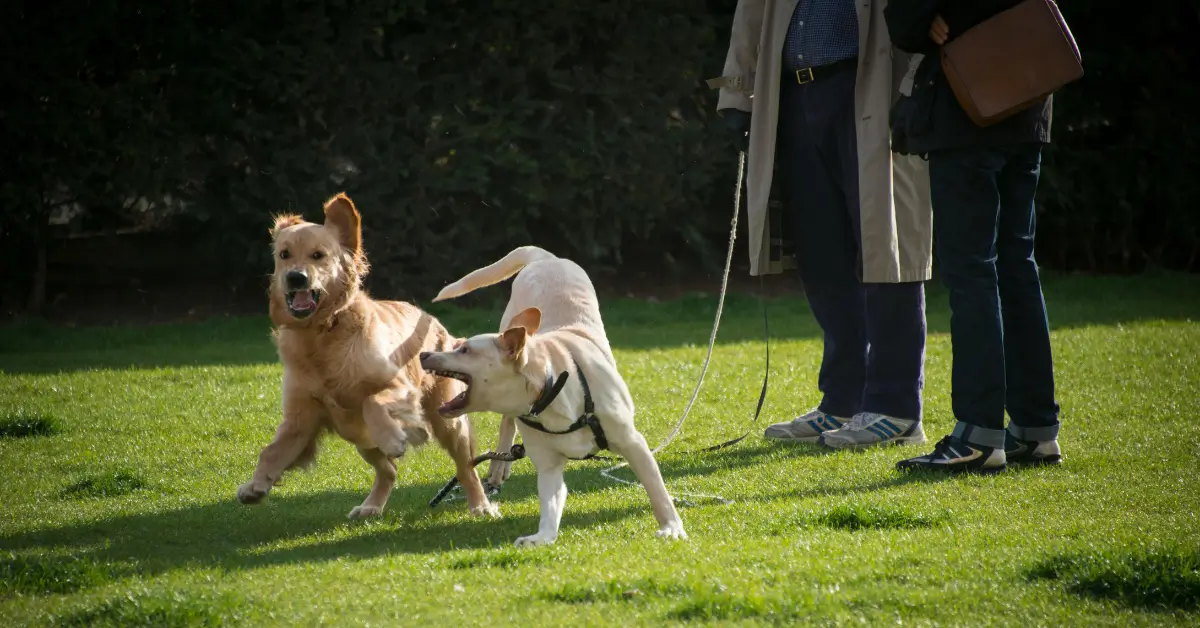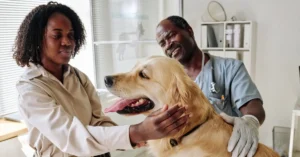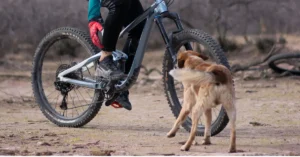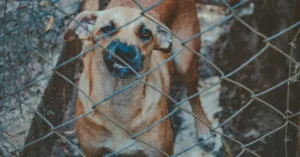Are you struggling to socialize with an aggressive dog? You’re not alone. Many dog owners face challenges when their pets display aggressive behaviors. This guide will help you understand the steps and strategies needed to help your dog become a friendlier, more sociable companion. Learning how to socialize an aggressive dog into a calm and social one isn’t just a dream; with patience and the right techniques, it’s entirely possible.
The first step is recognizing that every aggressive pup can learn to interact safely. This process involves understanding the reasons behind their fear of aggression or the need to protect their crate. By addressing these root causes, you can start socializing with others and create positive changes.
Decoding Aggression in Dogs
Understanding why a dog acts aggressively is key to helping them. Learning about these causes is the first step in changing aggressive dog behavior problems for the better. It’s important to remember that aggression is a response that can be managed with the right training techniques.
Exploring the Different Forms of Dog Aggression
Dog aggression varies by genetics, experiences, and training. Identifying if aggression is fearful, defensive, or territorial helps tailor interventions. Professional trainers recommend positive reinforcement and specific dominance to help your pet behave better around others, which is crucial for safe and effective socialization.
The Crucial Role of Early Socialization in Preventing Aggression
Initiating your puppy to various people, animals, and environments early on can prevent many aggressive behaviors later. This early training, crucial for your pet’s development, uses positive reinforcement and order to reinforce good behavior and build a well-adjusted nature.
Laying the Groundwork for Successful Socialization
Preparing your dog for socialization involves building a foundation of trust and teaching basic commands to ensure the dog’s safety and responsiveness.
Cultivating Trust and Confidence in Your Dog
Building a trusting relationship with your dog is the first step towards successful socialization. This involves consistent, positive interactions that reinforce your dog’s sense of security and belonging.
The Essentials of Basic Obedience Training
Training your dog for basic dominance like ‘sit,’ ‘stay,’ and ‘come’ is essential. Obedience training not only aids in socialization but also ensures you can manage your dog’s behavior effectively in any aggression.
Strategies for Gradual and Safe Exposure
Introducing your dog to new experiences must be done kindly to prevent reinforcing their aggression. Gradual exposure to new people, animals, and environments can help desensitize your dog to potential triggers.
Creating Controlled Social Environments
Start by introducing your dog to new stimuli in controlled environments. This can include having a furry friend walk their dog at a distance your dog is comfortable with, gradually decreasing this distance over time.
Gradually Increasing Social Interactions and Stimuli
Incremental exposure helps your dog adjust without becoming nervous or scared. This method slowly increases the number, duration, and intensity of exposure sessions to new stimuli and environments.
Navigating Challenges and Aggressive Behaviors
Handling setbacks calmly and strategically is crucial in dealing with an aggressive dog. Recognizing warning signs and knowing when to intervene can prevent escalations and setbacks.
Identifying and Reacting to Aggression Triggers
Knowing what triggers your dog’s aggression — such as specific sights, sounds, or situations—allows you to effectively manage and prepare for these instances. Listing and understanding these triggers can be a valuable tool in modifying your dog’s aggressive responses.
When to Seek Professional Help for Dog Aggression
Sometimes, professional help from a trained behaviorist is necessary, especially if your dog displays severe aggression. A professional can offer targeted advice and strategies tailored specifically to your dog’s needs.
Essential Safety Tips to Socialize an Aggressive Dog and Precautions
Ensuring your dog’s and others’ safety is paramount during the socialization process. Taking proactive measures can help prevent accidents and improve the overall success of socializing your aggressive dog.
Implementing Muzzles and Leashes for Safety
Using a muzzle can be a beneficial safety measure, especially when your dog can bite. Ensure the muzzle fits comfortably, allowing your dog to pant and get treats. Similarly, a sturdy leash provides discipline and security, making it easier to manage your dog’s lunge during socialization sessions.
Understanding and Respecting Your Dog’s Social Boundaries
It’s essential to recognize your dog’s limits. Pushing your dog too far too fast can lead to setbacks. Observe their body language closely and learn to identify signs of stress or discomfort, such as avoiding eye contact, yawning, or licking lips, which might indicate feeling overwhelmed.
Recognizing and Encouraging Your Dog’s Social Milestones
Celebrating your dog’s progress is crucial for reinforcing good behavior and maintaining momentum in their socialization journey. Acknowledging small wins and big milestones can motivate continued efforts and help build a positive association with social interactions.
Celebrating Behavioral Improvements and Progress
As your dog becomes more comfortable around others, it’s important to recognize and reward this progress. Tracking improvements can be as simple as noting fewer instances of aggression during walks or more relaxed behavior around new people. Each positive interaction is a step forward and should be considered a significant achievement.
Sustaining Socialization Efforts Over Time
Maintaining your dog’s socialization involves continuous exposure to various scenarios under controlled conditions. This ongoing effort helps prevent regression in their behavior and ensures they remain comfortable in social situations. Regularly arranging playdates with other dogs, visiting new environments, and continuous training sessions are all part of sustaining good social habits.
Wrapping Up: The Journey to a Well-Socialized Dog
Socializing an aggressive dog requires commitment, understanding, and a tailored approach that suits your pet’s unique needs. As we’ve explored in this guide, starting with basic obedience training and gradually introducing your dog to new situations can create a foundation for safer and more positive interactions.
Remember, progress may become slow, and there may be setbacks, but each step forward is a step towards a more peaceful coexistence with your dog. Celebrate the small victories along the way and remain patient and consistent with your efforts.
Frequently Asked Questions
Q: What are some ways to socialize an aggressive dog safely?
A: When socializing an aggressive dog, start slowly in a calm, secure setting. Employ positive reinforcement such as giving your dog treats and praise to encourage good behavior.
Q: How can I tell if my dog might be aggressive towards another dog?
A: Dogs often display signs before becoming aggressive. Watch for your dog stiffening, growling, or staring intensely at another dog. These signs can indicate that your dog is uncomfortable and might be aggressive if the situation escalates. If you see these signs, removing your dog from the situation calmly and quickly is best.
Q: Should I hire a professional dog trainer for my aggressive dog?
A: Yes, working with a professional dog trainer can be very beneficial, especially if you feel overwhelmed. Trainers can provide the right dog training techniques and strategies tailored to your dog’s specific issues. They can also help you understand your dog’s behavior better and guide you in managing it safely.
Q: What should I do if my dog starts to nip or bite during socialization?
A: If your dog begins to nip or bite, it’s crucial to address this behavior immediately. Redirect their attention to something positive, like a toy or a command they know well. Taking a step back in your socialization process might also be necessary. Consult a professional if this behavior becomes a common occurrence.
Q: How often should I practice socialization exercises with my dog?
A: Regular practice is key to successfully socializing your dog. Aim for daily sessions, starting with just a few minutes at a time and gradually increasing as your dog becomes more comfortable. Consistency helps reinforce learning and helps your dog adjust to being around other dogs and people more easily.
Q: Can all breeds of dogs be socialized the same way?
A: While the basic principles of socialization apply to all dogs, different breeds might require different approaches. For instance, some breeds may have a stronger guarding instinct and might find it more challenging to socialize with other dogs. Knowing your dog’s breed characteristics can help you tailor your approach effectively.
Q: What role does conditioning play in socializing an aggressive dog?
A: Conditioning is essential for helping your dog link new people and dogs with positive experiences. This training method exposes your dog to triggers in a controlled manner to avoid aggression. Over time, your dog will associate these triggers with positive rewards like treats or praise, significantly reducing aggressive behaviors.




